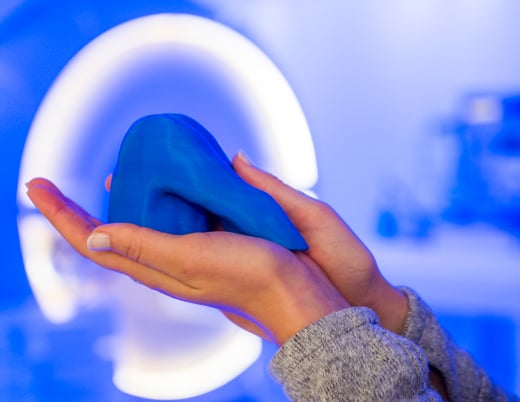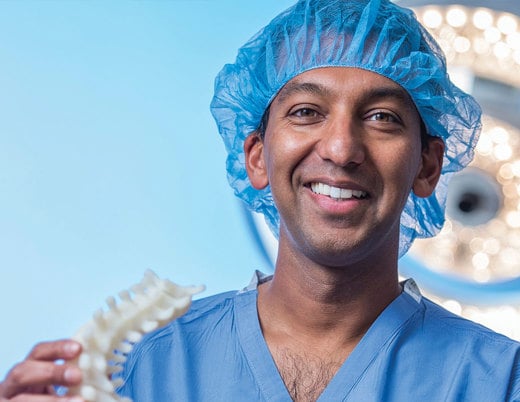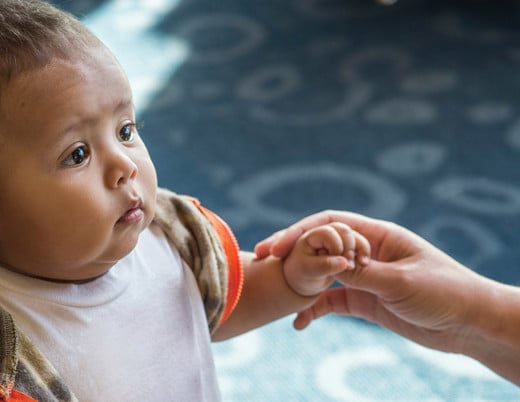How can research and education advance the standard of care for children and teens with hip dysplasia and encourage a narcotic-free pain management routine?
An all-women team of pediatric orthopedic surgeons at Children’s Hospital Colorado is challenging the status quo with their hip dysplasia research. Gaia Georgopoulos, MD, Margaret Siobhan Murphy- Zane, MD, Nancy Hadley-Miller, MD, and Courtney Selberg, MD, are aiming to not only provide the best care, but also create a whole-patient experience that is unique to Children’s Colorado by incorporating education into the treatment process. This is helping babies get the care they need sooner and helping to decrease the need for pain medication post-procedure. Together, this team of surgeons conducts research and care for kids across the entire pediatric experience from infant diagnosis into early adulthood.
Assessing Pavlik harness treatment guidelines
Developmental dysplasia of the hip is a relatively common condition where the hip joint develops abnormally, making the round, upper end of the femur bone sit improperly in the hip socket. The cause is unknown but believed to be a developmental issue that occurs before or after birth. The most common treatment for infants is the Pavlik harness, a soft splint that supports the baby’s feet all the way up to the shoulders, helping keep the baby’s hips in a proper position. Babies typically wear the harness for 12 weeks and require intense caretaker oversight as the baby’s movement is very limited.
Children’s Colorado’s orthopedic surgery team is constantly evaluating the effectiveness of their protocols to ask themselves: Do infants actually require a full 12 weeks of treatment or are we overtreating patients? How can we make our care optimal for the patients and easier for the parents?
Drs. Georgopoulos, Murphy-Zane and Hadley-Miller have published several recent studies advancing the standard of care for the Pavlik harness and expanding the knowledge on ongoing management. The group is making these evaluations by studying the baby’s age, risk factors, bracing ability and more. These types of studies are possible thanks to the hip registry this team is building at Children’s Colorado, where researchers can dive into the data for a clear understanding of what the research shows is effective. This registry will also allow the team to continue tracking these patients over a longer period of time, opening up opportunities for personalized treatment for this group of patients in the future.
“We are continually evaluating our protocols and making changes to make things a little easier for the families — not so many visits or not so many ultrasounds,” Dr. Georgopolos says. “The hip registry makes it easy for us to go back and look at these and other factors, allowing us to ask good, targeted research questions that then can be translated into more personalized care.”
The group recently found babies don’t always need the full 12 weeks of the Pavlik harness to make a full recovery, allowing some families to end that treatment earlier or slowly wean off the treatment before the 12-week mark. This approach still offers many benefits without sacrificing long-term outcomes.
Hip dysplasia ultrasound and X-ray guidelines
Another study revealed the importance of the six-month X-ray and ultrasound in the ongoing management of hip dysplasia. They found that these tests are particularly valuable in predicting residual dysplasia in the future, which can lead to an increased risk for osteoarthritis and functional limitations.
Dr. Murphy-Zane says, “I think that our manuscripts reflect that you can have a treatment that works really well, but you have to make sure that you’re doing it for the right reasons. And that has been what our papers have focused on. Are there ways that we can make it easier? For sure.”
Outreach is also a key part of the work Drs. Georgopolos, Murphy-Zane and Hadley-Miller are doing to improve care for infants with hip dysplasia. The group connects with pediatricians to help educate them on sensitive risk factors for hip dysplasia in babies.
“The education has really made a difference in how often we are seeing these kiddos before things get pretty bad,” Dr. Murphy Zane says. “Our goal is to not do surgery on these kids. Our goal is to see them early enough that we can treat them with nonoperative methods.”
Expanding access to the periacetabular osteotomy (PAO) procedure
Dr. Selberg is the final piece to the puzzle. Her research and care focuses on teenagers. For teens with symptomatic hip dysplasia, the periacetabular osteotomy (PAO) procedure is one of the main treatments to correct the hip positioning. Dr. Selberg and her team have created a whole-patient experience that is unique to Children’s Colorado by infusing education into the treatment process to limit the need for pain medication post-procedure.
The team offers a hip education class every month for patients with upcoming PAO surgery. The virtual class gathers physical therapists, nurses and physician assistants to help patients understand the nuts and bolts of surgery and what to expect from recovery. This class also provides a unique opportunity for the patients to hear from a former patient to learn more about their experience.
“They want to know what their scar looked like and how it was going back to school,” Dr. Selberg says. “We do a lot of education before surgery, so we can make sure our patients are on board — that they have their work set up and their home environment set up. I find it really helps people be more successful with the outcome of their surgery and be happy about it.”
Dr. Selberg and her team have found this is helping patients feel more confident and prepared before surgery. The team is also analyzing the benefits of using a dedicated perioperative team protocol for the PAO procedure, including anesthesia providers specializing in hip procedures and an intraoperative neuromonitoring team. So far, they have found this approach minimizes blood loss, shortens operative time and lowers transfusion rates. Dr. Selberg presented these findings to the Pediatric Orthopaedic Society of North America in 2022.
Non-narcotic pain management
The other main focus of Dr. Selberg’s research is looking at ways to implement a non-narcotic pain management routine. Right now, she is conducting a pilot study using the HeartMath device — a small machine that measures heart variability. Participants are trained in perioperative resiliency, providing them with a toolkit of options for coping with surgery and recovery, such as various breathing techniques.
“When they are in the hospital, they can employ some of these techniques for taking control of their breathing, visualizing what options they have to ask for help and getting up to move around,” Dr. Selberg explains. “The first answer is not, ‘They just need more pain medication.’ Setting up the expectation that we have lots of tools in our toolkit for dealing with pain really helps it become very manageable for patients.”
These education opportunities, paired with the research on the benefits of a perioperative team protocol, are setting patients up for success and allowing teenagers to use less pain medication post-operation.
“Those things really distinguish our center for excellence in terms of doing surgery in a safe way and making sure we are minimizing narcotic use and minimizing hospital stay,” Dr. Selberg says. “That’s definitely one of our strengths.”
Featured Researchers

Gaia Georgopoulos, MD
Orthopedic surgeon
The Orthopedics Institute
Children’s Hospital Colorado
Associate professor
Orthopedics
University of Colorado School of Medicine

Margaret Siobhan Murphy-Zane, MD
Orthopedic surgeon
The Orthopedics Institute
Children’s Hospital Colorado
Associate professor of clinical practice
Orthopedics
University of Colorado School of Medicine

Courtney Selberg, MD
Orthopedic surgeon
The Orthopedics Institute
Children's Hospital Colorado
Assistant professor of clinical practice
Orthopedics
University of Colorado School of Medicine

Nancy Hadley-Miller, MD
Orthopedic Surgery
Children’s Hospital Colorado
Professor
Orthopedics
University of Colorado School of Medicine





 720-777-0123
720-777-0123










